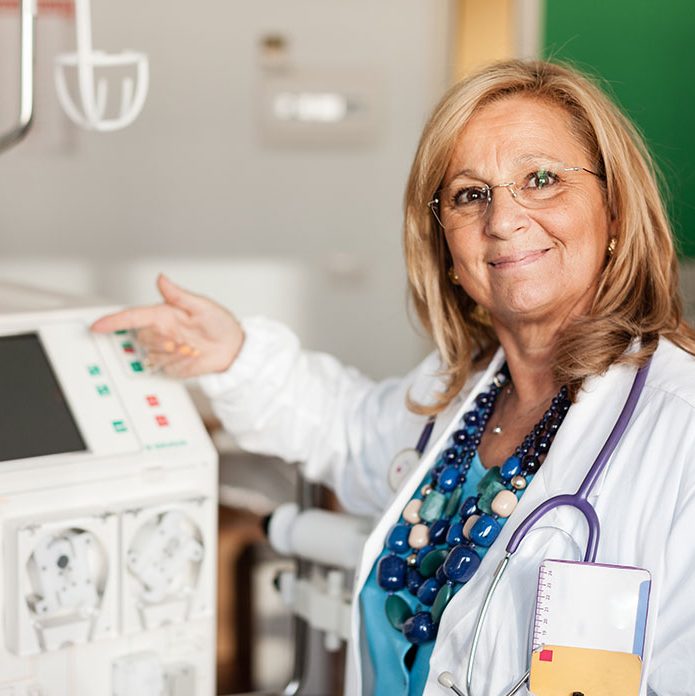Dialysis Modalities
HEMODIALYSIS
- Hemodialysis: in-center treatment, with some areas now offering nocturnal treatment
- Home hemodialysis, requiring a well-trained partner to assist with cannulation and ongoing monitoring during the treatment.
Hemodialysis: removes waste products and water directly from the blood. While the person sits in a chair, specialized nurses and technicians insert needles into the person’s artery and vein and the blood is pumped through a filter.
A special solution flows in the opposite direction, picking up urea and other toxins along the way to take them out of the body. Careful monitoring is carried out by the dialysis nurses or technicians and adjustments to bicarbonate, sodium and potassium must be made to keep things in balance.
Characteristics of hemodialysis treatments
- Hemodialysis treatments are usually 3-4 hours, or 6-8 hours in the case of nocturnal hemodialysis, 3-4 times weekly in a clinic or hospital setting.
- Hemodialysis requires more dietary and fluid-intake restrictions since toxins are removed only three times a week or so. Nocturnal hemodialysis requires less fluid and fewer dietary restrictions due to longer filtration time.
- Travel arrangements must be made in advance with a dialysis clinic near the destination and the patient’s records must be transferred by the home dialysis team.
- A reliable ‘access’ to the bloodstream (good veins and arteries) are needed for this treatment option to work. Access options include
- Primary arteriovenous fistula (done surgically by a vascular surgeon)
- Synthetic (man-made) arteriovenous graft
- Cuffed, tunneled catheter known as “permacaths”
Home Hemodialysis
Home dialysis uses the same principle as hemodialysis carried out in a clinic, but this is done in the person’s home by a caregiver who has had special, fairly rigorous training. The advantages of home hemodialysis include the following:
- Daily treatments can be shorter in duration.
- The need for difficult fluid restrictions, dietary restrictions, and binders for electrolytes such as phosphorus and potassium may be reduced.
- Treatments of longer duration can sometimes be prescribed every other day for certain patients.
- People on hemodialysis often report feeling better with home hemodialysis than they did on hemodialysis carried out only three times per week.
- The hope for home hemodialyis is that overall health outcomes will be improved, though this is a fairly new treatment option with limited experience and data.
It is important to note that while home hemodialysis eliminates the need to travel to a clinic three times weekly, the primary responsibility for the person with CKD lies squarely in the hands of the caregiver. In the event of an emergency, professionals are available by phone to assist.
Peritoneal dialysis
- Continuous ambulatory peritoneal dialysis (CAPD)
- Continuous cycling peritoneal dialysis (CCPD)
Peritoneal Dialysis (PD) works by a different principle to remove toxins from the body. It uses the body’s natural filtering system—the abdominal (belly) lining called the peritoneal membrane. This membrane surrounds the peritoneal cavity which houses the stomach, spleen, liver and intestines. Fluid is drained into the peritoneal cavity through a catheter and the fluid draws toxins from the blood through small capillaries and across the peritoneal membrane into the dialysate (the dialysis solution). This fluid is changed periodically (called an ‘exchange’) so that toxins can be drawn out of the body and into the solution all day long. Blood is not leaving your body and no needles are involved. PD is performed every day.
This treatment modality is often tolerated better by elderly people with CKD than hemodialysis. However, setting up the treatment requires a good eye and a steady hand, so a caregiver may be needed for an elderly person on PD.
Peritoneal Dialysis Options
- Continuous Ambulatory Peritoneal Dialysis (CAPD) is carried out several times a day using a gravity system and minimal equipment
- Continuous Cycling Peritoneal Dialysis (CCPD) is carried out every night using an automated pumping machine.
- PD can be performed in any clean room whether the person is home or away.
- Since PD is performed daily, dietary and fluid restrictions are usually less rigid than with hemodialysis.
- Travel is easier since dialysis fluids can be sent ahead to most destinations worldwide.
- PD requires the insertion of a cuffed, tunneled catheter to be placed into the person’s peritoneal cavity. The catheter can be used after one or two weeks of healing time.
Peritoneal Dialysis has three stages: drain, fill, and dwell. Once the dialysate along with waste products is drained out of the patient, fresh dialysate flows into the peritoneal cavity (fill). The dialysate solution remains in the person for several hours (dwell) to give the body’s natural filtering system—the peritoneal membrane—time to draw toxins from the blood. Then the fluid is drained out and the cycle continues.



